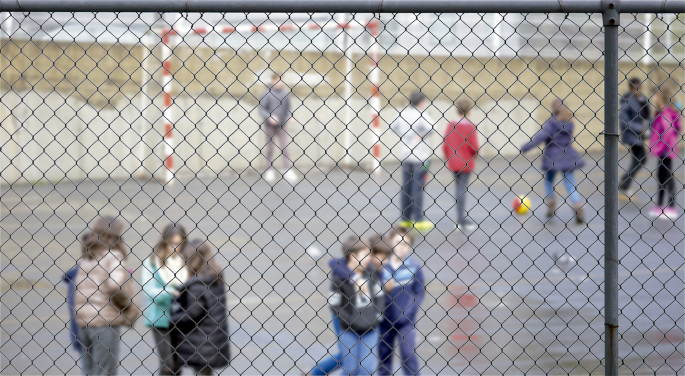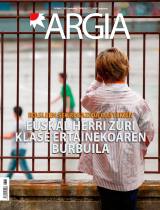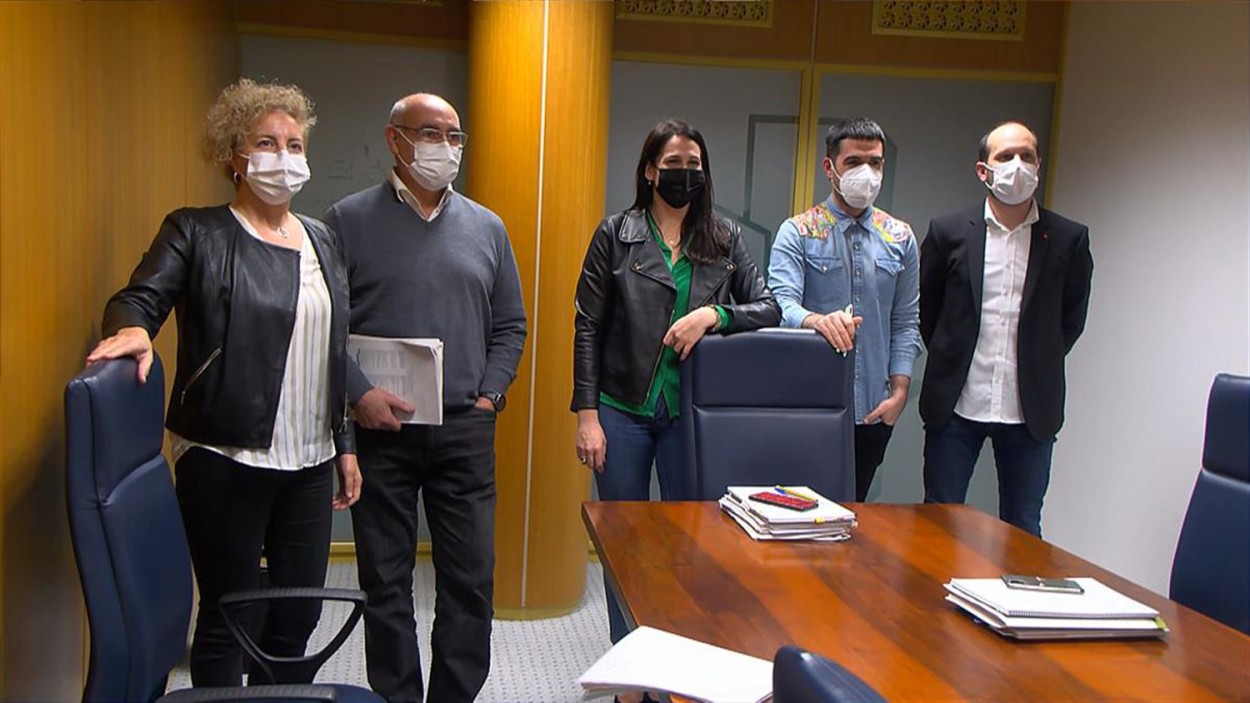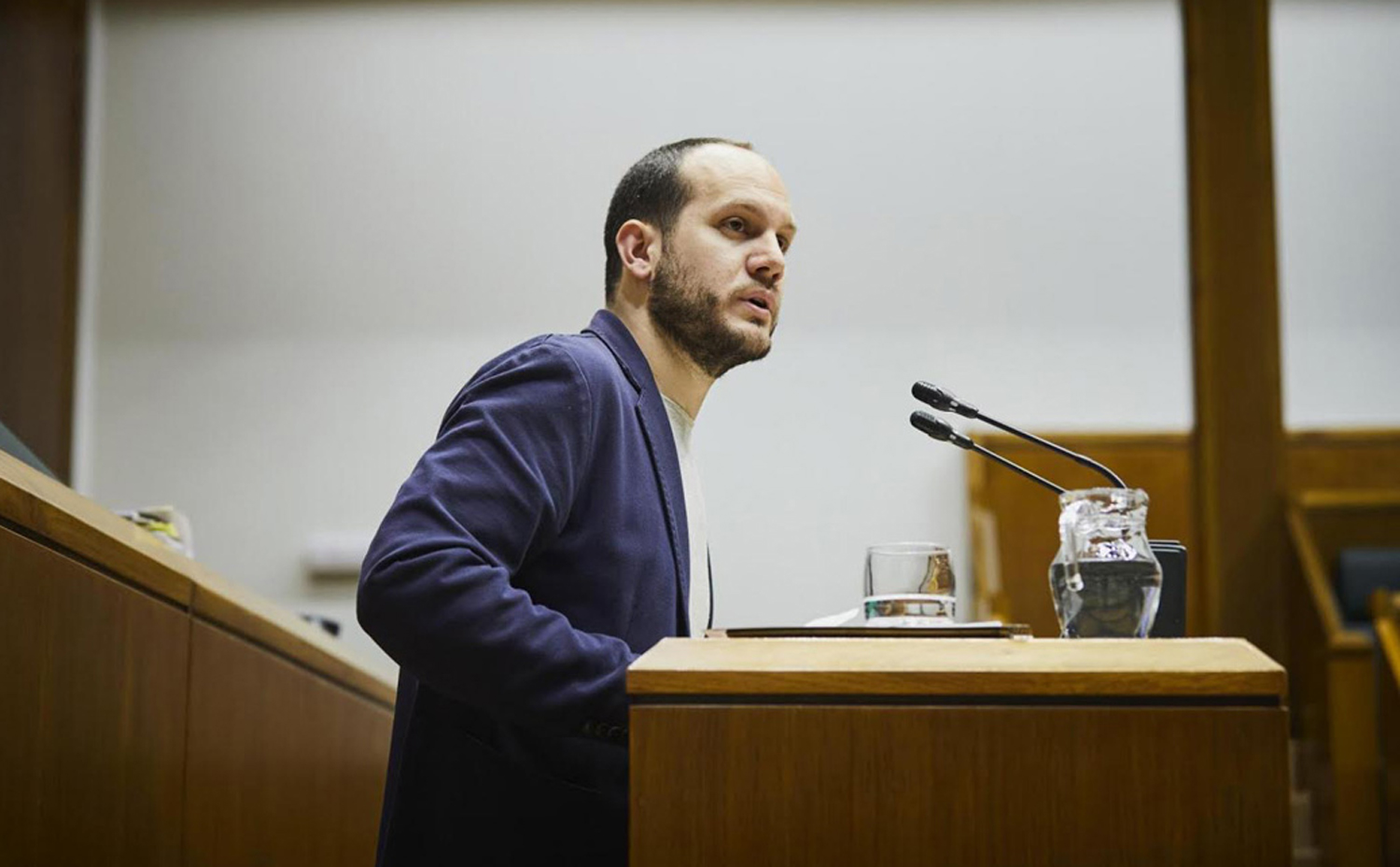Barriers to coexistence
- Recently, all the associations of mothers and fathers of the public school in the capital have denounced the segregation of children in the educational centers of Vitoria-Gasteiz. They have warned that bubbles without diversity, ghettos of foreign origin, on the one hand, are fragmenting society and are creating two parallel schools. More or less, Vitoria-Gasteiz is the paradigm of the open phenomenon in the Basque Country.

They have also joined the manifesto of fathers and mothers, such as Denon Eskola, the Network of Directors of Public Centres, all unions, numerous social associations in the city and collectives from various backgrounds. The manifesto has a clear starting point: diversity is good, enriching; the current society is plural in gender, in sexual tendencies, in religions, in origin, in cultures, in the socioeconomic situation… and so it should also be reflected in school. In short, the school is the first meeting point and basis for social cohesion; beyond theory, in a practical way, through the exchange between different, all this diversity is an instrument to live and improve coexistence. “The diverse classroom prepares children for the future because the vitorian society is plural and if they don’t know each other, they will turn their backs,” says Maider Ruiz de Egino. He is a father of a Vitorian family who is one of the drivers of the manifesto.
What's the problem? The obvious imbalance between centres generates artificial concentrations, extreme situations and difficulties. They have pointed out that 20 centers in Vitoria-Gasteiz experience a “non-normalized” situation, since in some classrooms of these centers the number of foreign students exceeds 30%, 50% and 80% – see data in the final graph of the report. These are students who come with specific needs of a temporary nature, for example in the field of language, and with whom the teacher often has to start from scratch, often even in the middle course. “In the class, whether immigrants or deaf, when special needs arise, they cannot be adequately attended when there are 17 students with special needs in the same class. We are all different, but there are students who need concrete help and their accumulation in the same class creates difficulties in the academic environment and in everyday life,” says Aitor Idigoras. Idigoras is a teacher at a public school in Vitoria-Gasteiz, is a teacher of parents and is a member of the Steilas union, among others.
One school for the indigenous population and another for people of foreign origin, the trend is becoming more and more evident. “They ask us to learn the language, to accept the culture, to behave like people here… but we have rights to the same extent that we have obligations,” said Samira Bouazzaoui. He is Moroccan, has been living in Vitoria-Gasteiz for 12 years, and almost all students have his 3 year old son in a foreign class: “My son learns the family culture at home and I want him to also learn the culture of here, with people here, on the street and at school. I want to educate myself in a culture that is also theirs, to learn many things… but the school is a ghetto of immigrants, and there it will never integrate.” Bouazzaoui feels that they are being asked for integration and at the same time are being denied the opportunity to do so.
Aitor Idigoras, professor: "There are centers that don't want Arabs and don't think red or different. Schools living in this extreme situation should rethink their educational model"
Beyond race, class conflict
The interviewees have emphasized that the issue is deeper and more complex. “The number of immigrants is the most spectacular and significant, but the bottom line is classism,” says Idigeres, because socially disadvantaged immigrants accumulate, not the children of Baskonia players. On the other hand, in these beautiful schools we will also see other groups with a low socioeconomic profile, as well as many other students with special needs”. This is a direct way to educational failure, since in centers where low socioeconomic and cultural levels predominate, academic indicators are worse. “However, if we mix students from low and high socioeconomic levels, we would be able to improve the results and the average,” says the professor.
Bouazzaoui tells us that parents have had to hire a private company with educators to help children with special needs in their children's school. “It’s a lot of money for us and the Administration should put the solution, not us.”
Public vs. concerted
Of the 20 educational centers in Vitoria-Gasteiz in which students of foreign origin are concentrated, 19 are public and one concerted or concerted: the Christian school. “What does the Christian school do? Concentrate the share of immigrants it receives in a single centre and not take any in the rest of its centres or just a few. In other towns it also behaves in the same way,” Idigoras said.
Samira Bouazzaoui, mother: "My son and his companions assimilate that the other is Euskaldun, 'we have been educated in centers outside'," he added. That's not feeling part of the vitorian society."
Samira Bouazzaoui did the experiment: he tried to enroll his son in a concerted center. He knocked at the door in five schools in Vitoria and the five answered that no: “They told me that when my son was a Muslim he could not enter Christian school, that in a second there was a plaza but that they did not believe that my son would meet the conditions and that he would better leave me, that on another occasion they received me very badly, with contempt, that he had to pay the fees, if my son was a Muslim and wanted to choose religion to go to public school… I left crying. My son was born here, is Basque and should have the same rights as the other children here.”
Beyond their origin, students with special needs are concentrated in the public school, according to the data. According to the last report of the City of Vitoria-Gasteiz, for example, between the 2010-2011 and the 2013-2014 academic year in the concerted centers, no student with special educational needs was enrolled in Early Childhood Education. “There are centers that tend to homogenize in the worst sense; they don’t want Arabs or Colombians, they don’t want deaf, or they think differently… The centers that live in this extreme situation should rethink their educational model. ‘Let our children from Euskaldunes not get infected’: this reality, beyond Vitoria-Gasteiz, we see it, we listen to it and we live it in all places, to a greater or lesser extent,” the professor said. And he added that the first barrier to segregation is economic, since the classrooms of 2 years are not arranged, but receive subsidies each year by decree, “and through that trap they do not have to comply with the students’ balanced reception standard”. That is, the quotas are legal in the classrooms of 2 years, “and we know the quotas of 200-300 euros”.
This imbalance between the public and the concerted is not natural, according to Ruiz de Egino: “The Department of Education, Cristina Uriarte, said that the reality of the neighborhood is reflected, but it is not true, because in the same neighborhood we find a public center with more than 70% of foreign students, and at the same time a concerted one with a maximum of 5%”. In addition, in the Vitoria-Gasteiz neighborhood where there are more immigrants, the percentage of immigrants is 18%, so the figures obtained are not a reflection of the neighborhood. The right of families to choose a school also seems a slippery argument to Idigoras: “Okay, we’re going to guarantee Gasteiztars the right to choose school, but everyone, not just some.”
Ruiz de Egino considers that the concerted centers turn their backs on the cohesion and integration of the city. “Many families think they pay a fee and that gives them the right to take the child to the center they want with special characteristics, and that’s not the case. The financing of the concerted centres is provided with 100% public money (another thing is that 100% of the budget that the centre has is not covered by the administration) and that requires rules of play”, said Idigoras.
M. Ruiz de Egino, father: "It is not true that the reality of the neighborhood is reflected. We have in the same neighborhood a public school of foreign origin with 70% of the students and 5% of the concerted"
We ask Xabier Arrieta, president of the Federation of Ikastolas de Álava, if they turn their backs on social cohesion and if they do not sufficiently accept the students of a certain profile: “By no means. The ikastolas meet the requirements established by the Basque Government when it comes to welcoming the students, both at the first tuition and in the case of the students who are dedicated to the ikastolas, either here or there. I would say more, we have the will to welcome the number of immigrants that we are entitled to, and we want to help these students enter our language, our culture, ultimately our society”. He has told us about the ikastolas of Bermeo or Ordizia, as well as the five towns of Gipuzkoa that have the ikastola as the only center of the locality; cases that demonstrate “exemplary integration”, according to Arrieta. He has spoken to us in favour of a balanced reception of the students, which is enriching and that “diversity has to start from the center”.
For the president of the Ikastolas alavesas, however, the question is the linguistic model: “The majority of immigrants are educated in Model A, both in the public and in the concerted, they are Model A centers that risk becoming ghettos. The education of immigrant students in model D facilitates integration and balance”. He has also put another variable on the table: “If we want balance, we will also have to balance the resources allocated to the public and to the concerted, because today most of the resources are allocated to the public”.
Xabier Arrieta, Federation of Ikastolas de Álava: "The ikastolas meet the conditions imposed by the Basque Government. What is more, we want to make our contribution so that these students can enter our language, our culture, our society"
However, segregation centers have exceeded Model A and at present accumulation occurs mainly in Model D schools. Therefore, we ask against Ruiz de Egino e Idigoras: Is language the argument of parents who don't want to confuse their children with foreign students? Ruiz de Egino does not believe that reason is a possible obstacle to the child's Euskaldunization, since many of the parents who have left these centers are not vasco-speakers. Idigoras is clear: the child will not learn less or more Basque because in the classroom there are four or five immigrants, and if the distribution was balanced, there would be the number of immigrants per class. “This concern occurs precisely in the families of the Basque area – he added – and it makes no sense, because if he lives with the Basque and Basque families, three or four immigrants will have no influence, at most he will learn a few words of Arabic. I believe that in the background there is an ethnocentrist perspective and an identity weight, which is often racism and that the Basque Country is an excuse. Your son or daughter will have more than 12 out of every 20 school hours in Euskera, as the Heziberri plan of the Basque Government has eliminated the hours of Euskera for the benefit of English”.
On the subject of resources, the professor has recalled that in recent years too, resources have been greatly reduced in public schools, in the budget, in the staff, in the infrastructure... However, care must be taken, “because claiming that these center ghettos need more resources can be an alibi, so that there are many resources and so that they remain where there is, and this is not the case, but change the basic policies for the school.”
A bomb that could explode in the future
Exclusion generates more exclusion, more exclusion and, if not reoriented, in Vitoria-Gasteiz and the Basque Country in general we are sowing a dangerous soil, according to the interviewees. They have told us about Paris, about the consequences of the accumulation of people of a certain origin. We have been highlighted by the prejudices and false criteria that many vitorians and vitorians have, the serious harm they can suffer in ignorance and ignorance. “My son is the Basque of the future, but what he and his colleagues assimilate is that the others are Basques, ‘we have been educated in extraordinary centers’, and that is not coexistence, it is not feeling part of the Vitorian society”. And the consolidation of a polarized and weak society is the crumbling of the roof of everyone.

Effective and feasible measures that only require will
The signatories to the manifesto affirm that compliance with the law and the implementation of concrete measures on the table is the only thing that is needed to redirect the situation, that political will is the key. One of the main proposals is the single registration office or window, which includes representatives of trade unions and families. Thus, centralizing enrollment would not be in the hands of each center, informal processes would be avoided, and it would be easier to ensure equitable criteria. They have also called for the course not to start above the ratio of students, as the signatories have denounced that in some concerted centers, if 23 children are to be welcomed in class, the classrooms are “shielded” and must be destined for students who come out of time to the public school. They also call for the elimination of economic quotas and similar obstacles so that families with lower incomes can register in the concerted centres. Conversely, they want to eliminate the income divide: low-income families have points to register in public and middle- and high-income families are destined for the concerted one. The limit is €42,000, but the average household income in Vitoria-Gasteiz is over €42,000: “It’s a way to expel middle-level families from public school, and in the center must be the families of all levels, from the bottom and from the middle,” says Ruiz de Egino. The adequacy of the ratios to the classrooms, with a ratio of 25 children in one classroom and an excess in another classroom, as well as economic resources and reinforcement teachers, among others.
“The government says I was going to denounce, but I’m fighting for a more global solution.”
In the face of all these complaints and petitions, the first reaction of the Department of Education of the Basque Government has been to focus attention on the case of Samira Bouazzaoui. In view of the discrimination she has suffered in registering her child, she has been repeatedly asked to report to these centres to use official channels. “They have repeated to me – Bouazzaou- that I did not have to go to the media, which I had to denounce. I tell you that this is not a personal issue, that I am fighting for a more global solution, and I do not want to denounce and treat it as a unique case, because I am defending many immigrants and the children of many immigrants. If all the immigrants who suffer from the situation present a complaint, I too will denounce it, but if I master more or less the language and have the courage to denounce the situation in public, it does not mean that everyone else can do so. And even if my son goes to a standardized school tomorrow, I'll keep fighting until this social problem is solved. In addition, the data is there, in plain sight, you are really waiting in the 21st century, when is a Moroccan woman going to denounce to do something?”
Positive conclusions have also been drawn from the meetings held with the Department of Education, however: Bouazzaoui has underlined that the counsellor has gone from denying that there was any problem in recognising the imbalance and announcing that they will take steps to prevent it, and that is a step forward.
Aitor Idigoras did not trust: “They will continue to apply patches, because they do not want to change the situation, they believe in the dual educational system, within the framework of Europe 2020. Unless this blow on the table leads to the mobilization and reflection of the people.” Maider Ruiz de Egino has hopes, and not only with the counselor, but they are also bringing their parents together with politicians from all parties and with the mayor of Vitoria-Gasteiz to get the commitment of the leaders.
A. Idigoras, professor: "What does the Christian school do? Concentrate the share of immigrants it receives in a single centre and do not collect it in the rest of its centres"
Citizen responsibility
Beyond the Administration, it is also up to citizens to reflect on the educational model. However, the interviewees state that many fathers and mothers who have the child in more homogeneous centers join the manifesto and that on many occasions it is the administration itself, with measures such as income, which leads them to the public school and not to the concerted one. The interviewees are clear: this is not a struggle between parents, but something that the employers and the government have to solve.
However, they also have a message for parents: Beyond “This is the education I want for my son,” think: “For my son, what kind of city do I want?” In the words of the professor, “perhaps in twenty years your son will meet a conflicting city that no one wants. If you want to enter and live in a unique, perfect castle, but live in the world.”
The xenophobic discourse of former mayor Javier Maroto, the citizen platform Gora Gasteiz that emerged to reclaim a diverse city… They have lived a hot streak in the Alavese capital. “Even if the ignorant want to annul us, I have never felt less than the others,” Bouazzaoutells us. I am happy in this city and so far I have not felt discrimination. Moreover, words like ‘discrimination’, ‘ghetto’, ‘racism’ become very harsh. What hurts me is that I have made a great effort to live here, to learn here, to work here and to make my contribution to this society, and when I make it to the world that will be the man of tomorrow, I see that they do not accept it.”
























